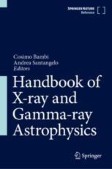Search
Search Results
-
Periodicity of Flare Frequency of Active Flare Stars Detected by Tess
Data from the TESS orbital observatory are used to study the most active flare stars indicating 100 or more flares during the period from July 2018...
-
Magnetic Fields in Chemically Peculiar and Related Stars. IX. Main Results Obtained in 2022 and an Analysis of Immediate Prospects
AbstractWe review the stellar magnetism studies published in 2022. We analyzed a total of 75 papers, which focus mostly on the study of magnetic...
-
Transiting Exoplanet Survey Satellite (TESS) Observations of Flares and Quasi-Periodic Pulsations from Low-Mass Stars and Potential Impact on Exoplanets
We have performed a search for flares and quasi-periodic pulsations (QPPs) from low-mass M-dwarf stars using Transient Exoplanet Survey Satellite ...

-
Mass Loss from the Atmosphere of the Planet WASP-193 b
Results are presented from an analysis of the manifestations of activity of the star WASP-193 of spectral class F9 with a super-neptune-type planet....
-
NO Biomarker: Transmission and Emission Methods for Its Potential Detection in Exoplanet Atmospheres with Spektr-UF (WSO-UV)
AbstractAmong all habitability factors for terrestrial exoplanets, one of the most important is the presence of a secondary N 2 –O 2 dominant...

-
Possible Atmospheric Diversity of Low Mass Exoplanets – Some Central Aspects
Exoplanetary science continues to excite and surprise with its rich diversity. We discuss here some key aspects potentially influencing the range of...

-
Detection of long-lasting aurora-like radio emission above a sunspot
Auroral radio emissions in planetary magnetospheres typically feature highly polarized, intense radio bursts, usually attributed to electron...

-
Space Missions for Exoplanet Science: Kepler/K2
The Kepler Mission is a space observatory launched in 2009 designed to monitor 170,000 stars over a period of 4 years to explore the structure and...
-
The Mass and Orbital-Period Distributions of Exoplanets Accounting for the Observational Selection of the Method for Measuring Radial Velocities. A Dominant (Averaged) Structure of Planetary Systems
AbstractStatistical distributions of exoplanets obtained by both ground-based and satellite telescopes are heavily distorted by observational...

-
Close Binary Stars. VI: New Research Methods
AbstractA review of new methods for studying close binary systems (CBSs) is presented. Methods for determining the masses of relativistic objects...

-
The metal-poor atmosphere of a potential sub-Neptune progenitor
Young transiting exoplanets offer a unique opportunity to characterize the atmospheres of freshly formed and evolving planets. We present the...

-
The Activity of Stars with Planetary Systems and Its Impact on the Loss of Atmosphere by Hot Exoplanets
AbstractThe review presents the results of a wide range of studies on modeling the atmospheres and shells of exoplanets and studying the processes...

-
Stellar Coronae
The vast majority of “normal” hydrogen-burning stars are of mass equal to or lower than that of our Sun, and they share with our host star the...
-
Analysis of the Activity of 11 K-type Dwarfs with Planets in the Habitable Zone
AbstractWe report the results of a study of spot activity manifestations in 11 K-type dwarfs with established planets in the habitable zone according...

-
A rich hydrocarbon chemistry and high C to O ratio in the inner disk around a very low-mass star
Carbon is an essential element for life but how much can be delivered to young planets is still an open question. The chemical characterization of...

-
Close Binary Stars. IV: Applications of the Roche Model
AbstractThe article describes various ways of applying the Roche model to close binary systems. A review of the verification of the evolutionary...

-
Extrasolar Planets and Star-Planet Interaction
Exoplanets, i.e., planets orbiting the stars other than the Sun, can be studied across the whole electromagnetic spectrum. In the context of X-ray...
-
Stellar Coronae
The vast majority of “normal” hydrogen-burning stars are of mass equal to or lower than that of our Sun, and they share with our host star the...
-
Planet Formation: Key Mechanisms and Global Models
Models of planet formation are built on underlying physical processes. In order to make sense of the origin of the planets we must first understand...
-
Science with a Small Two-Band UV-Photometry Mission II: Observations of Stars and Stellar Systems
We outline the impact of a small two-band UV-photometry satellite mission on the field of stellar physics, magnetospheres of stars, binaries, stellar...

